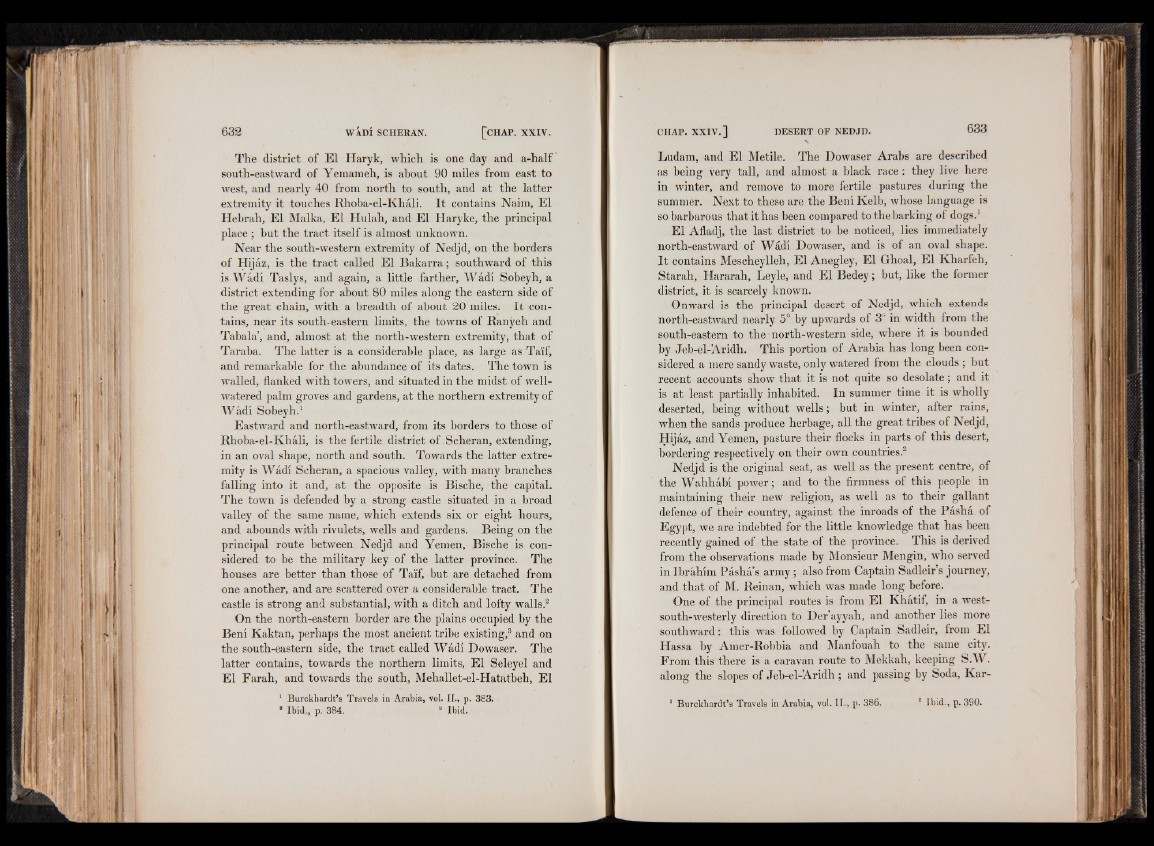
The district of El Haryk, which is one day and a-half
south-eastward of Yemameh, is about 90 miles from east to
west, and nearly 40 from north to south, and at the latter
extremity it touches Rhoba-el-Khali. It contains Naim, El
Hebrah, El Malka, El Hulah, and El Haryke, the principal
place ; but the tract itself is almost unknown.
Near the south-western extremity of Nedjd, on the borders
of Hijàz, is the tract called El Bakarra ; southward of this
is Wadi Taslys, and again, a little farther, Wadi Sobeyh, a
district extending for about 80 miles along the eastern side of
the great chain, with a breadth of about 20 miles. It contains,
near its south-eastern limits, the towns of Ranyeh and
Tabala’, and, almost at the north-western extremity, that of
Taraba. The latter is a considerable place, as large as Tai'f,
and remarkable for the abundance of its dates. The town is
wTalled, flanked with towers, and situated in the midst of well-
watered palm groves and gardens, at thè northern extremity of
Wadi Sobeyh.1
Eastward and north-eastward, from its borders to those of
Rhoba-el-Khali, is the fertile district of Scheran, extending,
in an oval shape, north and south. Towards the latter extremity
is Wadi Scheran, a spacious valley, with many branches
falling into it and, at the opposite is Bische, the capital.
The town is defended by a strong castle situated in a broad
valley of the same name, which extends six or eight hours,
and abounds with rivulets, wells and gardens. Being on the
principal route between Nedjd and Yemen, Bische is considered
to be the military key of the latter province. The
houses are better than those of Tai'f, but are detached from
one another, and are scattered over a considerable tract. The
castle is strong and substantial, with a ditch and lofty walls.2
On the north-eastern border are the plains occupied by the
Beni Kaktan, perhaps the most ancient tribe existing,3 and on
the south-eastern side, the tract called Wadi Dowaser. The
latter contains, towards the northern limits, El Seleyel and
El Farah, and towards the south, Mehallet-el-Hatatbeh, El
Ludam, and El Metile. The Dowaser Arabs are described
as being very tall, and almost a black race: they live here
in winter, and remove to more fertile pastures during the
summer. Next to these are the Beni Kelb, whose language is
so barbarous that it has been compared to the barking ol dogs.1
El Afladj, the last district to be noticed, lies immediately
north-eastward of Wadi Dowaser, and is of an oval shape.
It contains Mescheylleh, El Anegley, El Ghoal, El Kharfeh,
Starah, Hararah, Leyle, and El Bedey; but, like the former
district, it is scarcely known.
Onward is the principal desert of Nedjd, which extends
north-eastward nearly 5° by upwards of 3° in width from the
south-eastern to the north-western side, where it is bounded
by Jeb-el-Aridh. This portion of Arabia has long been considered
a mere sandy waste, only watered from the clouds ; but
recent accounts show that it is not quite so desolate; and it
is at least partially inhabited. In summer time it is wholly
deserted, being without wells; but in winter, after rains,
when the sands produce herbage, all the great tribes of Nedjd,
Hijaz, and Yemen, pasture their flocks in parts of this desert,
bordering respectively on their own countries.2
Nedjd is the original seat, as well as the present centre, of
the Wahhabi power; and to the firmness of this people in
maintaining their new religion, as well as to their gallant
defence of their country, against the inroads of the Pasha of
Egypt, we are indebted for the little knowledge that has been
recently gained of the state of the province. This is derived
from the observations made by Monsieur Mengin, who served
in Ibrahim Pasha’s army; also from Captain Sadleir’s journey,
and that of M. Reinan, which was made long before.
One of the principal routes is from El Khatif, in a west-
south-westerly direction to Der’ayyah, and another lies more
southward: this was followed by Captain Sadleir, from El
Hassa by Amer-Robbia and Manfouah to the same city.
From this there is a caravan route to Mekkah, keeping S.W.
along the slopes of Jeb-el-Aridh; and passing by Soda, Kar